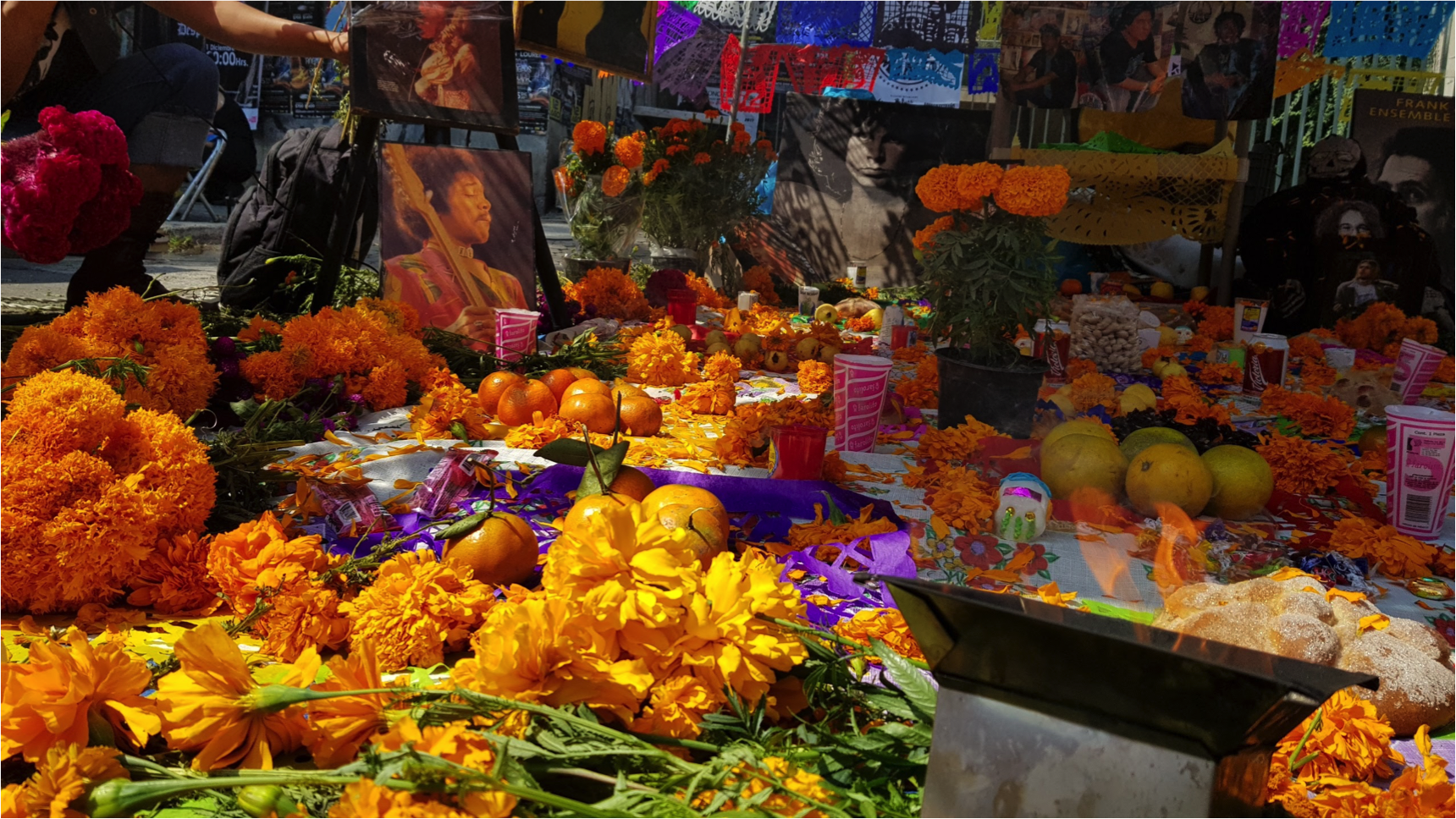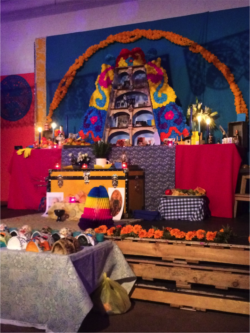Making the invisible visible – Day of the Dead, ofrendas and remembering in family life

Laura King, University of Leeds
Any good collaboration should be mutually beneficial – ‘which is a formal way of saying bloody lovely’. So said Ellie Harrison in a talk we gave about how we’ve worked together, at the University’s ‘Impact in 5’ evening last week, which showcased collaborations between academics and creative practitioners.
We’ve blogged before about the many wonderful things we’ve worked on with Ellie – from our conference on ‘The Senses and Spaces of Death, Dying and Remembrance’ last March to their brilliant caravan of grief which toured in June, accompanied by a series of meals. In our last post, Jessica Hammett wrote about the ethics of care and compassion that has underlined our work together – particularly crucial given the emotional nature of the subjects we’re working on. But I wanted to use a blog post to explore the specific ways in which working with Ellie has changed my thinking and research, and had an impact on our project.
In universities today, there’s a lot of pressure to show how research has an impact on our collaborators and audiences who might engage with it. But any good collaboration is naturally two-way. Ellie’s questions have often pushed my research into new areas – such as wanting to know how food has played a role in remembering the dead, something I went away and researched after Ellie decided to build meal celebrations into their tour. But what’s also been really interesting to see is how Ellie and the Grief Series have pushed me to think more comparatively, and helped advance my thinking on the processes and practices for remembering the dead which take place in families and other ‘emotional communities’.

Ofrenda at our conference, built by Ellie Harrison and Vlady Diaz. Photo credits - The Grief Series.
Ellie’s own collaborators involve artists from Mexico. The Grief Series team have now made two visits to Mexico – designer Bethany Wells is there now, taking part in Day of the Dead preparations and celebrations this week (check out Instagram for her amazing images). And we’ve welcomed Mexican artist Vlady Diaz to Leeds, and plan to host many more artists from Mexico over the coming year. This has been fascinating for me – not least through learning about the practice of ofrenda building. To celebrate Day of the Dead in Mexico, people build ofrendas (meaning ‘offerings’) to remember friends, family and people of significance. Ofrendas are brightly coloured displays including tables filled with photographs, flowers, candles, food and significant objects, that remind people of their loved ones who have died. They are a central part of celebrating the dead, from close family to heroes from music or sport. Ofrendas are built in people’s homes, in schools, places of work, bars, restaurants and public squares.
This is a fascinating comparison to practices in Britain, which do not centre on a particular time of year, or follow such a colourful format. But that’s not to say that families and friends have not found ways to commemorate their loved ones in Britain. Ceremonies around Remembrance Sunday in November provide a moment to remember those who have died in war, often in very public ways. But, particularly when people have died in unremarkable circumstances – of old age, for example – we might not be able to find such clear or active examples of personal remembrance as the annual tradition of the ofrenda. But they are there if we look hard enough. And as Ellie put it, perhaps thinking about ofrenda building can help us make visible processes which remain invisible here in the UK.
Our Mexican friends have given the Grief Series an ‘ofrenda kit’ which opens up all sorts of exciting potential for further collaboration, and to help communicate the research to different audiences – and Ellie is running a number of ofrenda building workshops over the next couple of weeks. But this in turn is helping me think about processes within families in the past. Is the ofrenda a visible example of what does take place within families in other countries – or is it something qualitatively different? How does the comparison of ofrenda building in Mexico help us understand how families form continuing bonds with their loved ones, and preserve their own histories in other cultural contexts? What does it mean to build ofrendas in workplaces, community spaces and streets as well as homes, and how might this help us understand the connection between the private and the public in different parts of the world?
These are all questions I’m taking back to my analysis. Some come from comparison between cultures, but some of these questions come from working with artists, who think a lot about the emotional experience of remembering and the performative nature of that act, whether it’s displaying a photo on a wall in a bedroom, or through an ofrenda each November. By being humble and respecting many different forms of expertise, whether its an artist we work with or those from different cultural backgrounds, we can learn a lot from our collaborators.
